
Today’s “home recording essentials” topic: Studio Monitors
And in the next few minutes, here’s some of the most fascinating nuggets we’ll reveal:
- The single most popular model for home studio beginners (it that’s you, your search is already over).
- How to be ultra-certain your mixes will sound just as good in the car, on headphones, or in your living room — as they do in your studio.
- The latest and greatest technology in studio monitors that actually tailors the sound to the acoustics of your room!
- PLUS… several iconic monitors that been used on countless world-famous mixes in the past several decades (the last is my absolute favorite)
Best Part: Just a few minutes from now, you’ll know this topic inside-n-out – and find exactly what you need for your studio budget… Guaranteed.
Here’s what you’re about to discover:
- The 9 Best Studio Monitors: How We Compiled the List
- The Most Popular Entry Level Studio Monitors Ever
- Secondary Monitors to Double-Check Your Mixes
- The Modern Remake of a Classic Industry Standard
- Studio Monitors That Look as Great as They Sound
- Studio Monitors That Adjust to Your Room
- Studio Monitors from the Top Name in Microphones
- High Tech Studio Monitors With a Next-Gen Tweeter
- An Affordable Option from the Standard in Pro Studios
- The Ultimate in Studio Monitors of Today
The 9 Best Studio Monitors: How We Compiled the List
When building this list, I set 3 Key Guidelines to ensure a good mix of options:
- Reputation is Key – more than any factor, the monitors with the best long-standing reputations are the ones that made this list. Since sound quality is extremely subjective, and product descriptions often sound the same, this seems the only fair way to judge them.
- $2k price cap – while some pro studio monitors can cost tens of thousands or more…the absolute most a home studio should have to spend on a quality pair of semi-pro monitors is around 2k.
- One brand, One pick – For a variety of options, I limited each brand to one spot max.
So here we go with list:
The Most Popular Entry Level Studio Monitors Ever
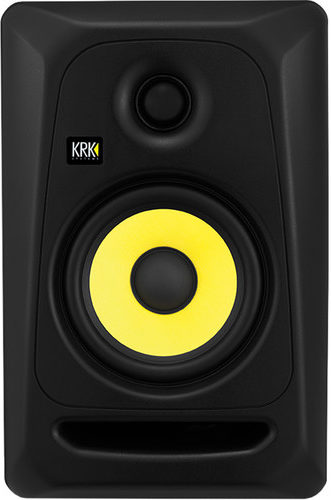
When you browse online at pictures of home studios…
One of the first things you’ll often notice is the distinctive yellow dots of the KRK Rokit 5 G4.
And that’s because, at the entry-level price point there is no other set of monitors….
- more popular
- more reviewed
- and more highly recommended
While most studio monitors in this price range receive far more complaints than praise…
In this case, you could read reviews for days without finding a single bad word about any of the KRK’s.
So for beginner studios, they’re the obvious choice, and the only ones I recommend.
- KRK Rokit 5 G4 – (Amazon/Sweetwater/Thomann)
Up next…
Secondary Monitors to Double-Check Your Mixes
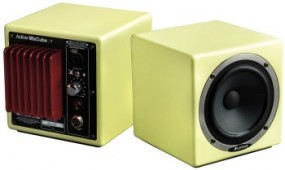
When mixing on a pair of high-end neutral studio monitors…
It’s quite common to come up with a mix that sounds great in your studio…but terrible on standard consumer speakers.
To solve this problem, many studios use a pair of secondary monitors that approximate how your mixes are likely to sound in ordinary life situations….like in your car for example.
The most famous of such secondary monitors is the Auratone 5C Super Sound Cube, invented way back in 1958.
For many decades, the Auratones were the industry standards in secondary reference monitors.
Once they were discontinued, many copycats arose…and the Avantone Mix Cubes, eventually became the new standard used today.
As a supplement to any monitors on this list, I highly recommend you grab yourself a pair of these as well.
- Avantone Mix Cubes – (Amazon/Sweetwater/Thomann)
Up next…
The Modern Remake of a Classic Industry Standard
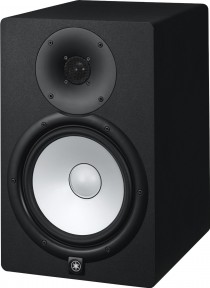
Instantly recognizable for their signature white-coned woofers, these Yamaha monitors solidified their iconic status long ago.
Based on the original Yamaha NS-10’s from back in the 70’s…the newer Yamaha HS Series combines a classic sound, with some new technology.
Notable features of the update include:
- isolated mounting system – which minimizes vibration and improves performance
- extra large magnets – for a smoother response over a wider frequency range
The most popular-sized models in this series include:
- HS5 – (5″ cone) – (Amazon/Sweetwater/Thomann)
- HS7 – (7″cone) – (Amazon/Sweetwater/Thomann)
- HS8 – (8″ cone) – (Amazon/Sweetwater/Thomann)
The most popular option that most people choose is the Yamaha HS8. So unless you have a reason to choose otherwise, I’d go with these by default.
Up next…
Studio Monitors That Look as Great as They Sound
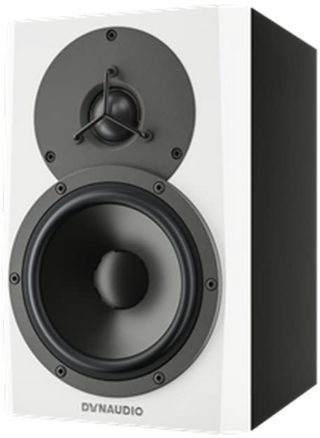
Established back in 1977, the Dynaudio Company is currently one of the most established brands in the field of studio monitors.
Among the most popular models in their lineup is the Dynaudio LYD5…which is actually one of today’s most popular monitors…period.
It addition to its amazing reference quality sound, the sleek and sophisticated look of these monitors are probably what makes them one of today’s trendiest models.
In addition to its modern design, other notable features include:
- soft high-frequency waveguide technology
- low, mid, and high frequency filters
- bass reflex cabinet with radius front edges
Check it out:
- Dynaudio LYD5 – (Amazon/Sweetwater/Thomann)
Up next…
Studio Monitors That Adjust to Your Room

Traditionally known mainly for their awesome mixers, Mackie is no slouch when it comes to studio monitors either.
And the insanely popular Mackie HR824 mkII is the perfect proof.
One of the most unique features of these monitors is its Acoustic Space Control, which provides 3 separate settings to provide optimal bass performance according to the dimensions of your room.
If you’ve spent much time in home studios with less-than-ideal dimensions…you know that room acoustics are perhaps the single greatest challenge of achieving pro sound in an amateur studio.
So if you’re looking for a convenient solution to this common problem, these monitors may be exactly what you need.
- Mackie HR824 mkII – (Amazon/Sweetwater)
Up next…
Studio Monitors from the Top Name in Microphones
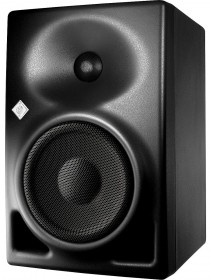
Known to literally everyone as the makers of the greatest microphones in the World…
The Neumann company, entered the studio monitor game back in 2010 when they absorbed the now retired Klein+Hummel line.
Their first release, respectfully titled Neumann KH line…has since become enormously popular.
The most popular model in this line is the Neumann KH 120, with notable features that include:
- Mathematically Modeled Dispersion (MMD) waveguide
- Titanium fabric dome drivers
- Composite sandwich cone design
If it’s within your price range, it’s an excellent choice that I’d highly recommend.
- Neumann KH 120 II – (Amazon/Sweetwater/Thomann)
Also check out the Neumann KH 120 D – (Amazon/Sweetwater) which which offers a unique internal digital converter that makes it possible to accept digital inputs as well.
Up next…
High Tech Studio Monitors With a Next-Gen Tweeter
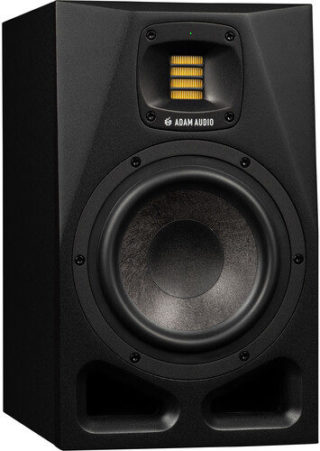
One of the youngest company on the list, Adam Audio was founded in Germany back in 1999.
The 3 lines of monitors they currently offer are:
- S series – (high end)
- F series – (entry level)
- A series – (mid-range)
No surprise, the A series is the most popular of the 3. And within it, the Adam Audio A7V is the most famous of all.
The most interesting feature worth noting is their high-tech HPS WaveguideX-ART Tweeter….
Capable of reproducing frequencies all the way up to 42kHz, which is well-beyond limit of human hearing (20kHz).
What that means is…they’re able to easily reproduce all frequencies within our hearing range, which ultimately results in an extremely flat response across the entire spectrum.
Another nice feature is its FRONT bass ports, which allows for closer placement to the walls in smaller rooms.
Check it out:
- Adam Audio A7V – (Amazon/Sweetwater/Thomann)
Up next…
An Affordable Option from the Standard in Pro Studios
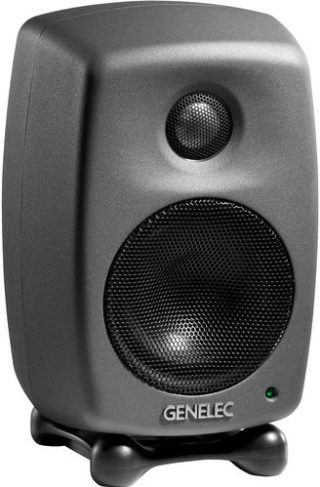
More than any name on this list, Genelec is the one most synonymous with ultra-high-end studio monitors.
In fact, most of their models are far too expensive to make this list. Some go as high as 10’s of thousands of dollars.
However, with their recent AWM series, Genelec has found a way to make themselves at least somewhat affordable to the average guy.
The most popular model of the series is the Genelec 8010.
Now while it does offer a few unique features that might appeal to some….
With the 8010’s or any Genelec monitor, what you’re really getting is the assurance of using the most trusted name in the industry.
So if you’re going to get them, get them for that. Here’s the link:
- Genelec 8010 – (Amazon/Sweetwater/Thomann)
And finally…
The Ultimate in Studio Monitors of Today
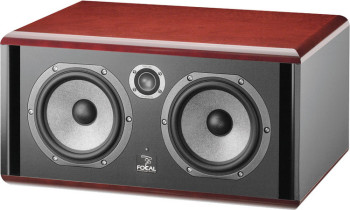
If you want the best of the best, the Focal Twin6 Be is it.
With a unique 3-way design normally reserved for the most ULTRA-high end monitors (costing 10’s of thousands)…
The Twin6 Be uses two identical 6.5″ drivers for the bass and mids, in addition to the tweeter.
As anyone who used them before would tell you, this extra 3rd cone makes one hell of difference in sound. And it’s the primary feature that sets these studio monitors apart from every other one we’ve covered on this list.
Now you would think that since these monitors are WAY pricier than the others…they’d also be less popular.
Yet despite their cost, they appear to be among the most popular set of monitors in ANY category. So if you can afford them, get them.
- Focal Twin6 – (Amazon/Sweetwater/Thomann)
By the way, if you found this post useful, I highly recommend joining our free Home Recording Secrets email newsletter where you’ll discover….
- How to Get Your First Studio Up and Running in a Single Weekend
- How to Avoid Wasting Thousands of Dollars on Unnecessary Pointless Purchases
- How to Get a “Million Dollar” Pro Studio Sound in a “Thousand Dollar” Home Studio
- PLUS… All Sorts of Other Amazing Insider Secrets Revealed
And it’s totally FREE! Click here and Enter Your Email to Sign Up.